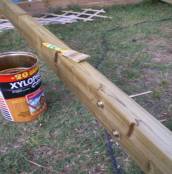|
The start is putting the decking planks on
reinforced founders by laying down the wall first taking into account the thickness
of the joists and the decking boards. We have also have stained all the
wood (even if they are pressure treated) in 2 different layers. Is this
really necessary? What I notice is that the said pressure treated wood is
not really treated into to heart. Make sure that there is no "water
trap" which will remain on the surface exposed to the weather.
Once the basis is laid, the rest will
follow automatically. It may be noted that the thickness of the plaster is irregular
so do not rely on plaster for proper dimensions! Size of the planks is:
145x 60x4000mm and the size of the joists is 60x70x4000mm
|

laying reinforced planks

Size of the planks are 145x 60x4000mm

adjusting the height of the deck structure

structure the deck frame


filling concrete pads
|
|
 
|
|
Make sure that there is no "water
trap" on the surface will remain exposed to the weather
|
|
Installing and fastening of the posts and
footings. The posts have a diameter of from 180 to 200 (which are in fact
recovery pipes) with a length of 50 to 60cm. The first hole is 25-30 cm
deep and then you should adjust the height by pushing them into the ground
(here, the soil is sand so it is deeper than if it were earth or rock
course). We just put blocks in the vertical height of the concrete is in
the pockets too. In short, all ideas are good, everything is good to adjust
the height of your supports!
|
|
 
|
|
Alignment using a line
|
|
  
|
|
Check with a quick installation of the
decking boards the spacing of 1m30 planks together, attaching the different
decking boards assembling (according to the joist spacing) with screws such
Easydrive, brackets and assembly plates and hooks. Note that the brackets
are placed in the tube ready to receive the concrete.
|
|
  
|
|
filling concrete pads
|
paraffin helps tremendously
|
apply the geotextile film if needed
|
|
Filling blocks of concrete (cement mixed
with normal quick-setting cement) and finish by screwing the rafters
To better penetrate the screws without
splitting wood, paraffin helps tremendously. The screw is made with a
screwdriver portable variable torque limitation + 2 batteries (38 € in a
DIY store).
And spend your ducts electrical and water
pipes ...
|
|
|
|
|

















